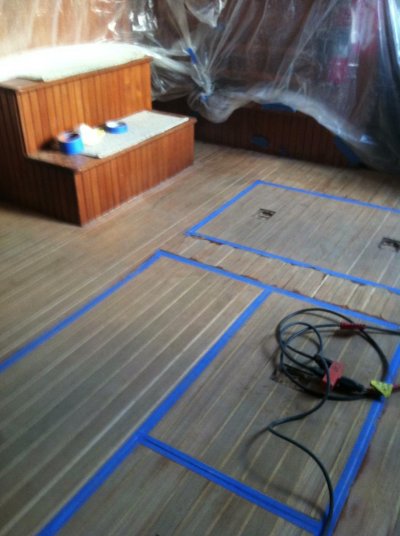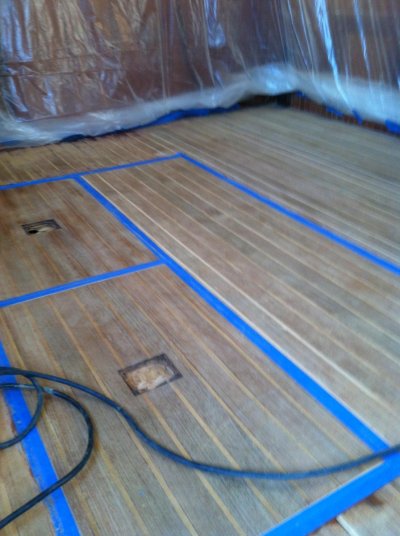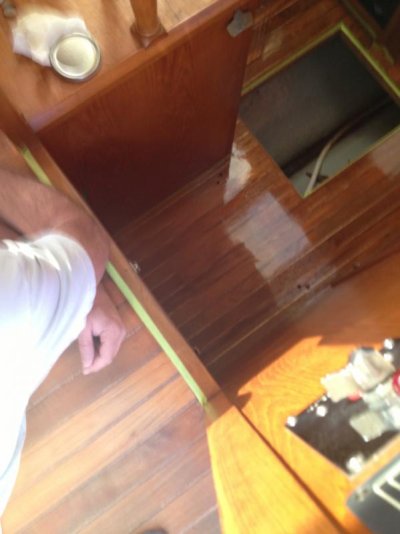Tom--- Have a slow evening here in Doha, Qatar so here are some of Bob Lowe's posts on refinishing the teak parquet cabin soles on GBs. Maybe there will be some information of use to you....
------------------------------------------
If you are simply applying varnish to freshen up the surface, are satisfied with the "color" and the parquet grain does not need filling or leveling, two coats should suffice. If you have bare areas, you might want to spon those with 4 coats of gloss first, blend sand and then apply a coat over the whole area.
When I refinish a teak parquet cabin sole down to bare wood, I apply 3 coats of CPES then 8 or more coats of a good gloss like Captain's or Crystal. When satisfied with the grain filling, I then apply two coats interlux satin varnish. If one prefers different finishes, I'm sure there are many that will work as well, they just happen to work well for me.
The reason satin or flat finishes are not as slippery is because their surface is rough, like fine sandpaper, so as to not reflect light like a smooth gloss finish. However, even satin can be a bit slippery when wet, especially on ladder or step edges which is why I prefer to leave the tops of outside steps bare teak and put non-skid strips of sand and varnish on the interior steps starting at the edge. Then a couple more back on the step.
--------------------------------------
I'm familiar with Minwax products but not on a boat, so no opinion on Minwax.
I have refinished many teak parquet floors and here is what works for me.
The parquet is probably a bit uneven with some glue joints loose, some with gaps of various sizes, depending on age and exposure.
Sand the floor with an aggressive grit, say 36/40 grit to remove the old finish and even the floor out. I like a 4" Makita belt sander and other smaller orbital sanders for the edges and corners, including scrapers and hand sanding. Then with progressively finer grits like 60, 80, 100, 150, and 220 with a random orbital sander and by hand where required.
Make sure to get good color removing all sun-bleached areas and stains. This is important for the best results.
Vacuum thoroughly including the gaps in parquet to remove all dust. Fill gaps with epoxy resin and trowel or fair with a putty knife to remove all excess. Resand to bare wood removing all surface epoxy. Apply 3 coats CPES. Then it's a matter of building a good base of varnish. I like Crystal for this as it builds fast, levels well and requires no sanding between coats if applied within the proper window of time.
After about 6 or so coats of Crystal gloss, sand with a random orbital to 220 finish.
Apply at least 3 coats Interlux Goldspar Satin Varnish sanding lightly between coats.
We found that this finish will hold up indefinitely depending on how used. We took our shoes off while inside. After 7 years it still looked like new. If wearing shoes inside, more wear, will need recoating more often.
-------------------------------------------------
I agree with Tom, in most cases. I follow a couple rules for gluing.
If there are any gaps in the glue joint, as is the case much of the time on boats, I use thickened epoxy which will fill any gaps. Be sure to thicken enough to not run out of the glue joint.
If the glue joint is well fitted with no gaps and can be well clamped while the glue is curing, I use a good wood glue, like Weldwood Plastic wood glue. It is brown and will do some minor surface gap filling, is strong and waterproof in most cases, though not for underwater use. Epoxy will squeeze out during the clamping process and the joint will be glue starved and weak. Epoxy needs some mass to be effective.
I also use the brown wood glue for plugs except for minor repairs that I want to complete in one day and the fit is good and then I use 5 minute epoxy. The brown glue will fill any surface gaps if left around the plug until cured and blend well with the wood.
--------------------------------------------------
Assuming that the cabin sole teak parquet is worn through the finish and the color is not even, I would approach the project by first looking to see if any of the parquet is loose and in need of re-gluing and do that first with epoxy.
If all parquet is well glued, does it have spaces between the parquet pieces from the teak drying out? If so, then I would squeegee some epoxy over the sole to fill those spaces. Then it’s time for sanding.
Generally, when it’s time to refinish a teak parquet cabin sole, there is some color problems from mildew in the wood grain (black) as well as areas where the finish is missing, worn and/or weathered away. There is also usually some unevenness to the surface. To get a good looking refinish job, it will be necessary to sand the deck thoroughly and aggressively to get it even and with good color. The parquet is about 3/8" thick, so sand away.
I find it much easier to sand the old finish off with a belt sander using 36 grit until most of the color is achieved, then 80 grit on the belt sander, followed by 100 grit, 150 grit and finally 220 grit on an aggressive random orbital sander, using a good dust collection system on all sanding. Corners and edges can be cleaned up with hand scraping for color and then light sanding. Sand with the hatches in place to even/level all out. They can be removed afterwards for varnishing.
I find it much easier and faster to get to a new varnishable surface in this manner, rather than removing the finish then sanding. I also don't like all the gunk that ends up in the open seams of the parquet when using paint/varnish remover. When sanding only, the sanding dust can be vacuumed out and then CPES and varnish.
When the teak is ready for varnish, apply 3 coats of CPES and then a coat of Captain’s or Crystal within a couple hours of the last coat of CPES. Lightly sand with 150 to knock down any roughness from wood fibers sticking up and apply successive coats of Crystal (or other good varnish that can be recoated without sanding) two coats per day until you have a total of at least 5 coats. Sand with 150 to help level the grain a bit and apply several more coats followed by more sanding to level the grain. When satisfied, apply a couple coats of Interlux 60 Goldspar Satin Varnish allowing a couple days drying and sanding between coats with 220. Be sure to stir the varnish frequently during varnish work.
----------------------------------


















